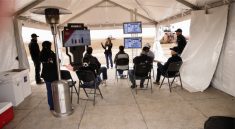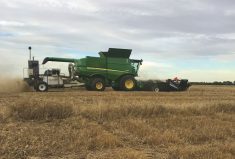As I walked through Kubota’s new headquarters in Grapevine, Texas, one particular observation stood out to me. In other companies’ offices and engineering centres that I’ve visited, there was never any shortage of images of the brand’s machines lining the hallway walls.
The offices in the Kubota building were stylish and comfortable with plenty of forward-thinking staff amenities like coffee bars and a gym, but the walls, by contrast with the other brands, were completely clean and uncluttered. It was, let’s say, pleasingly Spartan.
It’s an environment designed for distraction-free focus and concentration on the business at hand. That means no self-congratulation.
It’s also an environment that matches the brand and how its executives approach the business.
The previous evening, Kubota had launched its most powerful tractors to date, hoping these models would allow it to make yet more inroads into the North American farm machinery sector. When the company’s president Masatoshi Kimata took the podium to address a room full of the brand’s dealers at that launch, it was an example of the company showing the greatest possible respect to its customers.

As one of the company’s Canadian executives says, Kubota sees both end-users and retail dealers as its customers.
As company president, Kimata’s presence at the podium was not unexpected. The kind of hierarchical relationships common to Japanese business protocol would demand the presence of such a senior person. And what he had to say was as unique as the company’s office design.
In the past I’ve seen some other brand’s executives attend similar events with the message that dealers ought to consider themselves fortunate they had aligned themselves to such a top-notch organization, taking a kind of top-down view that put the brand above its dealers. The Japanese approach is the opposite.
Read Also

What to consider when setting up farm-related business ventures
Things to consider before launching a farm-adjacent side business.
In a society based on Confucianism, customers (in this case, dealers and farmers) are at the top of any hierarchical business relationship, and the vendor (Kubota) must be at the bottom. It’s known as “okyakusama wa kamisama desu” in Japanese. The English translation reads, “The customer is God.”
So the greatest respect must be paid by the company to those who would buy its machines. And what greater respect is there than to have the president of the company on hand to welcome dealers.
“First I want to express my sincere gratitude to all of you for your continuing efforts to support and sell Kubota products,” Kimata said as he opened his address.
The focus of the event was, of course, the unveiling of Kubota’s new M8 tractors, one more stride toward Kubota’s stated goal of becoming a major global brand in agriculture.

“It’s another step toward Kubota’s goal of becoming a market leader,” said Haruyuki (Harry) Yoshida, CEO of Kubota North America. “ [It’s a big step] toward becoming a global major brand. We are committed to becoming a serious competitor. We will continue to expand our presence in North America.”
The jump up into the mid-range tractor segment follows the brand’s acquisition of Norway’s Kverneland, which brought hay and forage along with specialized tillage implements into the fold. Then there was the purchase of Great Plains, a seeding and tillage implement manufacturer in the U.S. Now, the addition of M8 tractors wrap that all up into a much fuller ag equipment package.
“Today, at this moment, we will plow a new field,” Kimata told his dealers. “We will launch a new tractor to widen our business. We will launch a tractor over 200 horsepower to widen our customer segment.”
Yoshida added impact to that statement and hinted at the vision the company has for the future. “I know that five years from now we will look back and be certain that we were the pioneers who conquered new territory for Kubota,” he said.
“We’re not here as a flavour of the month,” said Bob Hickey, president of Kubota Canada, as he stood in front of an open-ended timeline history of the brand’s product development, which was projected on the stage behind him. The new tractors were the latest addition to it. They are central to the next step of the company’s growth strategy. “Future growth” was a phrase that was echoed many times over the course of the two-day event by more than one company executive.

The company is aware, however, of the stiff competition it faces from the other majors as it tries to break into the mid-horsepower tractor segment.
“It’s a very tough market,” said Kimata. “But we have to crack it.”
Cracking it, as Kimata sees it, involves teamwork, with dealers playing a major role. “I don’t think it’s impossible, because we have you,” he told the dealers. “We will grow the (market-) share with you. I am confident we can do it together.
“We have to keep showing our sincerity anytime and anywhere, from manufacturing to service,” he added. “Developing products which meet customers’ and dealers’ needs, manufacturing ability to surpass customers’ expectations, providing sales and service with caring for customers.”
Originally, Kubota catered primarily to the small-holding farmers common in Asia. But a few years ago it set its sights on a more global presence. The way forward was to grow its horsepower range. With the previous introduction of the M7 tractors a couple of years ago, the target was growth in Europe, where that tractor range had the broadest market appeal. The M7s are even built in France, rather than Japan.
Now the bigger M8s are part of the brand’s focus on North America. Unlike the M7s, these tractors are being first introduced here in the market they were designed for, and they’ll be built in Winnipeg, Man., through an OEM agreement with Buhler Industries (Versatile).
But among the market challenges the M8 will face is competition from a nearly identical twin, the Versatile Nemesis line of tractors built on the same base chassis, and on the same assembly line. So how will Kubota attempt to differentiate their version from the Versatile in the marketplace?
It will be through the Kubota philosophy, explained John Lee, U.S. marketing manager. “We focus in on Kubota as a brand. How we treat our dealers and customers. How we support our products. And that Kubota engineers were involved in its (the M8) development and set the specifications for it.”
Chosen from more than 1,000 in North America, these 80 dealers will be part of a select group to offer the M8s to their customers in an initial distribution strategy.
Said Lee, “We’re growing and learning… we’re in this for the long haul.”
















